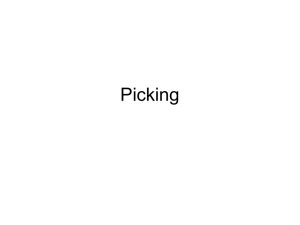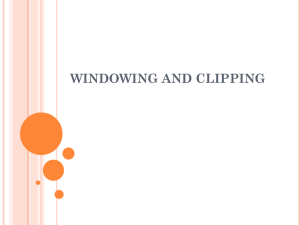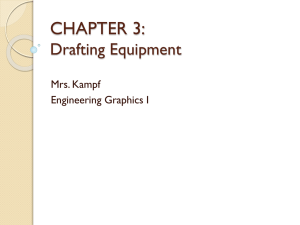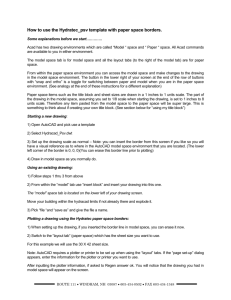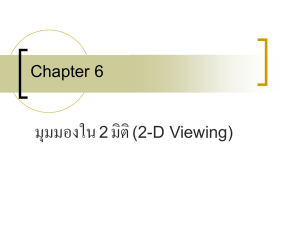Chapter 3 PowerPoint
advertisement
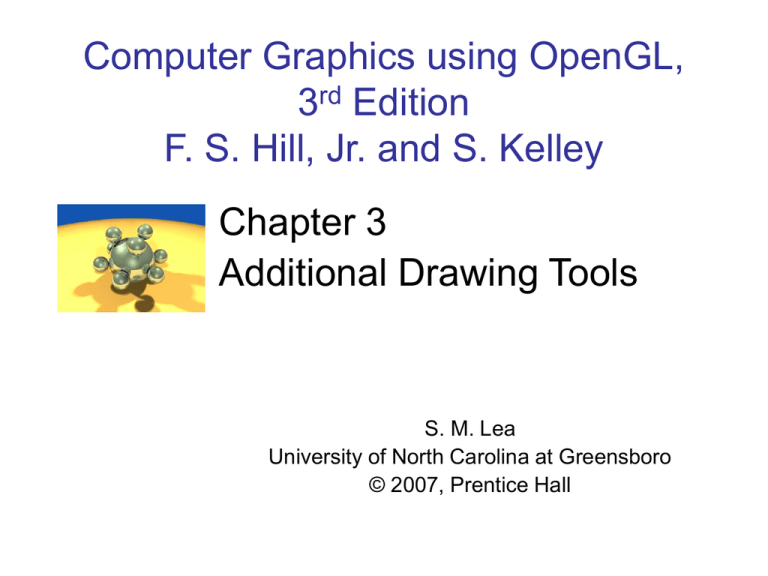
Computer Graphics using OpenGL,
3rd Edition
F. S. Hill, Jr. and S. Kelley
Chapter 3
Additional Drawing Tools
S. M. Lea
University of North Carolina at Greensboro
© 2007, Prentice Hall
More on Coordinate Systems
• We have been using the coordinate
system of the screen window (in pixels).
• The range is from 0 (left) to some value
screenWidth – 1 in x, and from 0 (usually
top) to some value screenHeight –1 in y.
– We can use only positive values of x and y.
– The values must have a large range (several
hundred pixels) to get a reasonable size
drawing.
Coordinate Systems (2)
• It may be much more natural to think in terms of
x varying from, say, -1 to 1, and y varying from –
100.0 to 20.0.
• We want to separate the coordinates we use in a
program to describe the geometrical object from
the coordinates we use to size and position the
pictures of the objects on the display.
• Description is usually referred to as a modeling
task, and displaying pictures as a viewing task.
Coordinate Systems (3)
• The space in which objects are described
is called world coordinates (the numbers
used for x and y are those in the world,
where the objects are defined).
• World coordinates use the Cartesian xycoordinate system used in mathematics,
based on whatever units are convenient.
Coordinate Systems (4)
• We define a rectangular world window in
these world coordinates.
• The world window specifies which part of
the world should be drawn: whichever part
lies inside the window should be drawn,
and whichever part lies outside should be
clipped away and not drawn.
• OpenGL does the clipping automatically.
Coordinate Systems (5)
• In addition, we define a rectangular viewport in
the screen window on the display.
• A mapping (consisting of scalings [change size]
and translations [move object]) between the
world window and the viewport is established by
OpenGL.
• The objects inside the world window appear
automatically at proper sizes and locations
inside the viewport (in screen coordinates,
which are pixel coordinates on the display).
Coordinate Systems Example
• We want to graph
sinc( x )
sin( x )
x
• Sinc(0) = 1 by
definition. Interesting
parts of the function
are in -4.0 ≤ x ≤ 4.0.
Coordinate Systems Example (2)
• The program which graphs this function is
given in Fig. 3.3.
• The function setWindow sets the world
window size:
void setWindow(GLdouble left, GLdouble
right, GLdouble bottom, GLdouble top)
{
glMatrixMode(GL_PROJECTION);
glLoadIdentity();
gluOrtho2D(left, right, bottom, top);}
Coordinate Systems Example (3)
• The function setViewport sets the screen
viewport size:
void setViewport(GLint left, GLint right, GLint
bottom, GLint top)
{ glViewport(left, bottom, right - left, top bottom);}
• Calls: setWindow(-5.0, 5.0, -0.3, 1.0);
•
setViewport(0, 640, 0, 480);
Windows and Viewports
• We use natural coordinates for what we are
drawing (the world window).
• OpenGL converts our coordinates to screen
coordinates when we set up a screen window
and a viewport. The viewport may be smaller
than the screen window. The default viewport is
the entire screen window.
• The conversion requires scaling and shifting:
mapping the world window to the screen window
and the viewport.
Windows and Viewport
Mapping Windows
• Windows are described by their left, top, right,
and bottom values, w.l, w.t, w.r, w.b.
• Viewports are described by the same values: v.l,
v.t, v.r, v.b, but in screen window coordinates.
Mapping (2)
• We can map any aligned rectangle to any
other aligned rectangle.
– If the aspect ratios of the 2 rectangles are not
the same, distortion will result.
y
V .l
W .t
W .l
V .r
V .t
W .r
x
W .b
w in d ow
V .b
view p ort
sx
sy
S creen w in d ow
Window-to-Viewport Mapping
• We want our mapping to be proportional:
for example, if x is ¼ of the way between
the left and right world window boundaries,
then the screen x (sx) should be ¼ of the
way between the left and right viewport
boundaries.
Window-to-Viewport Mapping (2)
• This requirement forces our mapping to be
linear.
– sx= Ax + C, sy = B y + D
– We require (sx – V.l)/(V.r – V.l) =
(x – W.l)/(W.r – W.l), giving
• sx = x*[(V.r-V.l)/(W.r-W.l)] + {V.l – W.l*[(V.rV.l)/(W.r-W.l)]}, or A = (V.r-V.l)/(W.r-W.l), C =
V.l – A*w.l
Window-to-Viewport Mapping (3)
– We likewise require (sy – V.b)/(V.t – V.b) =
(y – W.b)/(W.t – W.b), giving
• B = (V.t-V.b)/(W.t-W.b), D = V.b – B*W.b
• Summary: sx = A x + C, sy = B y + D,
with
V.r V.l
A
B
W .r W .l
V.t V.b
W .t W .b
, C V.l A W .l
, D V.b B W .b
GL Functions To Create the Map
• World window: void gluOrtho2D(GLdouble
left, GLdouble right, GLdouble bottom,
GLdouble top);
• Viewport: void glViewport(GLint x, GLint y,
GLint width, GLint height);
– This sets the lower left corner of the viewport,
along with its width and height.
GL Functions To Create the Map
(2)
• Because OpenGL uses matrices to set up all its
transformations, the call to gluOrtho2D() must be
preceded by two setup functions:
glMatrixMode(GL_PROJECTION);
and glLoadIdentity();
• setWindow() and setViewport() are useful code
“wrappers”.
– They simplify the process of creating the
window and viewport.
Application:Tiling with Viewports
Applications (continued)
• Tiling A was set up by the following code:
setWindow(0, 640.0, 0, 440.0); // set a fixed window
for (int i = 0; i < 5; i++) // for each column
for (int j = 0; j < 5; j++){ // for each row
{glViewport (i*64, j*44,64, 44); // set the next
viewport
drawPolylineFile("dino.dat"); // draw it again
}
• Tiling B requires more effort: you can only turn a
window upside down, not a viewport.
Applications (continued)
• Code for Tiling B
for (int i = 0; i < 5; i++) // for each column
for (int j = 0; j < 5; j++){ // for each row
if ((i + j) % 2 == 0){
setWindow(0.0, 640.0, 0.0, 440.0);
} else {
setWindow(0.0, 640.0, 440.0, 0.0); // upside-down
}
glViewport (i*64, j*44,64, 44); // no distortion
drawPolylineFile("dino.dat"); }
Application: Clip, Zoom and Pan
Clipping refers to viewing only the parts of
an image that are in the window.
Application (continued)
• The figure is a collection of concentric
hexagons of various sizes, each rotated
slightly with respect to the previous one. It
is drawn by a function called hexSwirl ();
• The figure showed 2 choices of world
windows.
• We can also use world windows for
zooming and roaming (panning).
Zooming and Panning
• To zoom, we pick a concentric set of
windows of decreasing size and display
them from outside in.
Zooming and Roaming (2)
• The animation of the zoom will probably
not be very smooth. We want to look at
one drawing while the next one is drawn,
and then switch to the new drawing.
– We use glutInitDisplayMode (GLUT_DOUBLE
| GLUT_RGB); //gives us 2 buffers, one to
look at and one to draw in
– We add glutSwapBuffers(); after the call to
hexSwirl (); // change to the new drawing
Roaming (Panning)
• To roam, or pan, we move a viewport
through various portions of the world. This
is easily accomplished by translating the
window to a new position.
• What sequence of windows would you
want in order to roam through the image?
Resizing the Screen Window
• Users are free to alter the size and aspect
ratio of the screen window.
• You may want GL to handle this event so
that your drawing does not get distorted.
• Register the reshape function:
glutReshapeFunc (myReshape);
• Void myReshape (GLsizei W, GLsizei H);
collects the new width and height for the
window.
Preserving Aspect Ratio
• We want the largest viewport which preserves
the aspect ratio R of the world window.
• Suppose the screen window has width W and
height H:
– If R > W/H, the viewport should be width W
and height W/R
– If R < W/H, the viewport should be width H*R
and height H
– What happens if R = W/H?
Automatic Aspect Ratio
Preservation for Viewports
Clipping Lines
• We want to draw only
the parts of lines that
are inside the world
window.
• To do this, we need to
replace line portions
outside the window by
lines along the
window boundaries.
The process is called
clipping the lines.
Clipping (2)
• The method we will
use is called CohenSutherland clipping.
• There are 2 trivial
cases: a line AB
totally inside the
window, which we
draw all of, and a line
CD totally outside the
window, which we do
not draw at all.
Clipping (3)
• For all lines, we give each endpoint of the line a
code specifying where it lies relative to the
window W:
Clipping (4)
• The diagram below shows Boolean codes for
the 9 possible regions the endpoint lies in (left,
above, below, right).
Clipping (5)
• A line consists of 2
endpoints
(vertices), P1 and
P2. If we do not
have a trivial case,
we must alter the
vertices to the
points where the
line intersects the
window boundaries
(replace P1 by A).
Clipping (6)
• In the diagram, d/dely
= e/delx (similar
triangles).
• Obviously, A.x = W.r.
• Also, delx = p1.x –
p2.x, dely = p1.y – p2.y
and e = p1.x – W.r.
• So A.y = p1.y – d.
A Line Needing 4 Clips
• The equation of the line is
y = x * (p1.y – p2.y)/(p1.x –
p2.x) + p2.y = mx + p2.y.
• The intersection B with
the top window boundary
is at x where y = W.t, or x
= (W.t – p2.y)/m.
• The intersection A with
the right boundary is y
where x = W.r, or y =
m*W.r + p2.y.
Clipping Pseudocode
• Complete pseudocode for the CohenSutherland Line Clipper is shown in Fig.
3.21.
Drawing Regular Polygons, Circles,
and Arcs
• A polygon is regular if it is simple, if all its sides
have equal length, and if adjacent sides meet at
equal interior angles.
• A polygon is simple if no two of its edges cross
each other. More precisely, only adjacent edges
can touch and only at their shared endpoint.
• We give the name n-gon to a regular polygon
having n sides; familiar examples are the 4-gon
(a square), an 8-gon (a regular octagon) and so
on.
Regular Polygons
Drawing Circles and Arcs
• Two methods:
– The center is given, along with a point on
the circle.
• Here drawCircle( IntPoint center, int radius)
can be used as soon as the radius is
known. If c is the center and p is the given
point on the circle, the radius is simply the
distance from c to p, found using the usual
Pythagorean Theorem.
Drawing Circles and Arcs
– Three points are given through which the
circle must pass.
• It is known that a unique circle passes
through any three points that don't lie in a
straight line.
• Finding the center and radius of this circle
is discussed in Chapter 4.
Successive Refinement of Curves
• Very complex curves can be fashioned
recursively by repeatedly “refining” a
simple curve.
• Example: the Koch curve, which produces
an infinitely long line within a region of
finite area.
Koch Curves
• Successive generations of the Koch curve
are denoted K0, K1, K2,…
• The 0-th generation shape K0 is just a
horizontal line of length 1.
• The curve K1 is created by dividing the line
K0 into three equal parts, and replacing the
middle section with a triangular bump
having sides of length 1/ 3. The total line
length is evidently 4 / 3.
Koch Curves (2)
• The second-order curve K2 is formed by
building a bump on each of the four line
segments of K1.
K 2:
K 1:
60°
1
1
Koch Snowflake (3 joined curves)
• Perimeter: the i-th generation shape Si is three
times the length of a simple Koch curve, 3(4/3)i,
which grows forever as i increases.
• Area inside the Koch snowflake: grows quite
slowly, and in the limit, the area of S∞ is only 8/5
the area of S0.
S0
S1
S2
Fifth-generation Koch Snowflake
Parametric Curves
• Three forms of equation for a given curve:
– Explicit: e.g., y = m*x + b
– Implicit: F(x, y) = 0; e.g., y – m*x –b = 0
– Parametric: x = x(t), y = y(t), t a parameter;
frequently, 0 ≤ t ≤ 1. E.g., P = P1*(1-t) + P2*t.
• P1 and P2 are 2D points with x and y
values. The parametric form is x = x1*(1-t) +
x2*t and y = y1*(1-t) + y2*t.
Specific Parametric Forms
• line: x = x1*(1-t) + x2*t and y = y1*(1-t) +
y2*t
• circle: x = r*cos(2π t), y = r*sin(2π t)
• ellipse: x = W*r*cos(2π t), y = H*r*sin(2π t)
– W and H are half-width and half-height.
Finding Implicit Form from
Parametric Form
• Combine the x(t) and y(t) equations to
eliminate t.
• Example: ellipse: x = W*r*cos(2π t), y =
H*r*sin(2π t)
– X2 = W2r2cos2(2π t), y2 = H2r2sin2(2π t).
– Dividing by the W or H factors and adding
gives (x/W)2 + (y/H)2 = 1, the implicit form.
Drawing Parametric Curves
• For a curve C with the parametric form P(t)
= (x(t), y(t)) as t varies from 0 to T, we use
samples of P(t) at closely spaced instants.
Drawing Parametric Curves (2)
– The position Pi = P(ti) = (x(ti), y(ti)) is
calculated for a sequence {ti} of times.
– The curve P(t) is approximated by the polyline
based on this sequence of points Pi.
Drawing Parametric Curves (3)
• Code:
// draw the curve (x(t), y(t)) using
// the array t[0],..,t[n-1] of sample times
glBegin(GL_LINES);
for(int i = 0; i < n; i++)
glVertex2f((x(t[i]), y(t[i]));
glEnd();
Parametric Curves: Advantages
• For drawing purposes, parametric forms
circumvent all of the difficulties of implicit
and explicit forms.
• Curves can be multi-valued, and they can
self-intersect any number of times.
• Verticality presents no special problem:
x(t) simply becomes constant over some
interval in t.
Polar Coordinates Parametric Form
• x = f(θ)*cos(θ), y = f(θ)*sinθ
– cardioid: f(θ) = K*(1 + cos(θ)), 0 ≤ θ ≤ 2π
– rose: f(θ) = K cos(n*θ), 0 ≤ θ ≤ 2nπ, where n
is number of petals (n odd) or twice the
number of petals (n even)
– spirals: Archimedean, f(θ) = Kθ; logarithmic,
f(θ) = Keaθ
• K is a scale factor for the curves.
Polar coordinates Parametric Form
(2)
– conic sections (ellipse, hyperbola, circle,
parabola): f(θ) = (1 ± e cos θ)-1
• e is eccentricity:
1 : parabola;
0 : circle;
between 0 and 1, ellipse;
greater than 1, hyperbola
Example for Ellipse
Shapes
• Cardioid, 2 rose
curves, Archimedean
spiral
